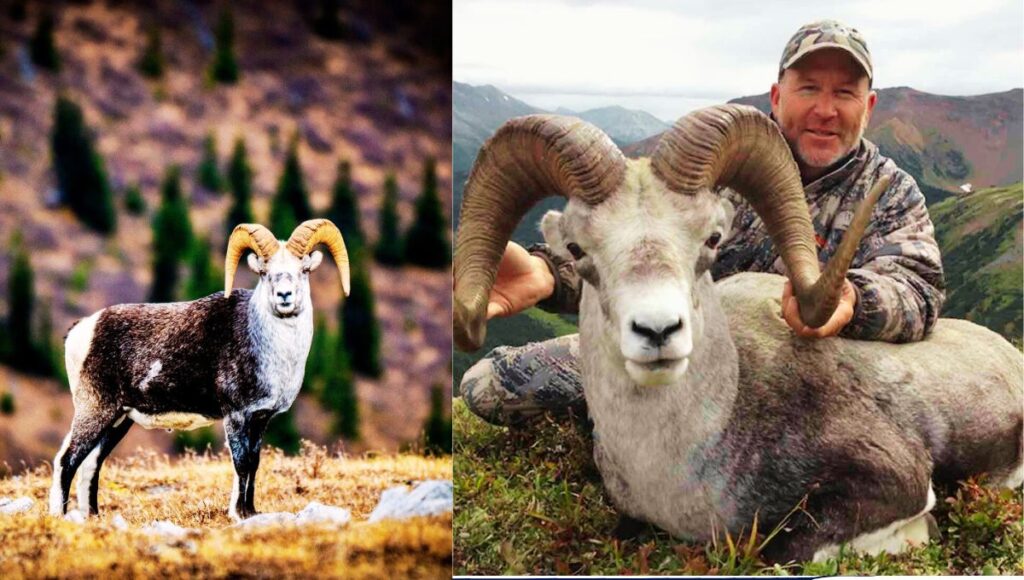Stone sheep are one of the three subspecies of Thinhorn Sheep or Ovis dalli. The sheep species attracts the attention of wildlife enthusiasts and photographers. In this article, we will delve into the stone sheep world and find some fascinating facts about the delightful creature.

Table of Contents
Stone Sheep- In a Glimpse:
| Common Name: | Stone Sheep |
| Scientific Name: | Ovis dalli stonei |
| Adult Length: | 1.5 m |
| Adult Weight: | 50-110 kg |
| Adult Colour: | Grey-White |
| Sexual Dimorphism? | Yes |
| Lifespan: | 14-16 Years |
| Range: | British Columbia and Southern Yukon. |
| Habitat: | Narrow linear ridges, talus-sloped and nearly vertical cliffs |
| Distinct Feature: | Mineral licking |
| Diets: | Green grasses, forbs |
| Predators: | Wolf packs, coyotes, black bears, and grizzly bears |
| Gestation Period: | 175 days |
| Breeding time: | Summer |
| IUCN status: | Least Concern |
Everything About Stone Sheep:
Scientific Classification:
| Domain: | Eukaryota |
| Kingdom: | Animalia |
| Phylum: | Chordata |
| Class: | Mammalia |
| Order: | Artiodactyla |
| Family: | Bovidae |
| Subfamily: | Caprinae |
| Tribe: | Caprini |
| Genus: | Ovis |
| Species: | O. dalli |
| Subspecies: | Ovis dalli stonei |
Relatives:
| Common Name | Scientific Name | Range | IUCN Status |
| Dall Sheep | Ovis dalli | North America | Least Concern |
| Fannin Sheep | N/A | North America | N/A |
Physical Appearance:

Stone sheep is a large sheep species that can be as tall as 1.5 meters in height and weigh between 50 and 110 kg. Their fur ranges from slate to grey-brown with a white rump patch, dark tail and white on the inside of the hind legs. There is also a grey-white coat with dark brown or black dorsal surface on the tails.
The horns are curved and vary from yellowish-brown to dark brown. Sexual dimorphism is present in the sheep species. The males have thick horns which grow more prominent and spiral with age whereas females have small and slender horns.
Lifespan:
Usually, Stone sheep live around 14-16 years in the wild.
Range and Habitat:
Primarily the entire population of Stone sheep is endemic to the Yukon border. The sheep inhabit mountainous areas of northern British Columbia and Southern Yukon.
A good sheep habitat includes narrow linear ridges, talus-sloped and nearly vertical cliffs interspersed with gently slopping saddles and alpine meadows with abundant vegetation.
Behaviour:

The stone sheep inhabits alpine slopes and plateaus and moves up higher to find succulent green grasses and forbs. In summer almost all sheep climb more than 1800 m above and store food for winter
In winter snow cover limits the availability of green vegetation and the sheep migrate to lower hills. In this situation, they prefer areas with less snow or wind-blown areas.
The average snow depth used by the sheep is 17 cm and the depth where they ceased digging for food was 32 cm.
Mineral licks are an important part of their life cycle. It is the means of replenishing mineral resources that were depleted during the winter season. The sheep are observed to lick rocks and hills primarily between April and July.
Diets:
The diets of the sheep consist of green grasses, forbs and other vegetation. Twigs, leaves, buds, pastoral sages, shrubs etc. are their main staples.
Reproduction:
The breeding season extends from mid-November to mid-December. The female sheep or ewes have a gestation period of 175 days with lambing in summer (May-June). Pregnant ewes leave the group and go to a very rocky and rugged place to give birth to the young in summer.
Threats:
- The stone sheep are well-known for their delicious meat. The locals traditionally hunt the sheep with bow and arrow.
- During the Gold Rush Years (1848-52), the species was almost extinct from the wild due to road construction and highway buildings.
Later the recovery process was successfully implemented and currently, the population of stone sheep is stable.
Predators:
Besides humans, wolf packs, coyotes, black bears, and grizzly bears are their main predators.
Conservation Status:
Stone sheep are not listed in the IUCN Red List of Threatened Species. But the parent species “Thinhorn Sheep” is listed as Least Concern.
6 Places to Watch Stone Sheep:
- Scoop Lake, British Columbia, Canada
- Racing River, Stikine Region, BC, Canada
- McDonald Creek, British Columbia, Canada
- Kechika/ Gataga River, British Columbia, Canada
- Turnagain River, British Columbia, Canada
- Moodie Lakes, British Columbia, Canada